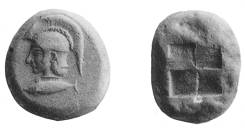
FIG. 268.



[Wroth, B. M. C., Mysia.]
Adramyteum. A seaport at the head of the bay of Adramyteum, said to have been founded by Adramys, brother of Croesus. With the earliest coins of this town cf. those of Iolla, and some of the Satrapal Coins (Ionia, infra).
|
Head of Zeus. [Cf. Imh., M. G., p. 246 f.] |
ΑΔΡΑ or ΑΔΡΑΜΥ Forepart of
winged horse.
Æ .6
|
| Head of Apollo r. laur. with long hair. [Hirsch, Auct. Cat. XIII, Pl. XXXVII. 3280.] |
ΑΔΡΑΜΥ ΤΗΝΩΝ Cup (kylix) with tall stem.
Æ .65
|
| Head of young Dionysos. [N. C., 1894, p. 10.] |
ΑΔΡΑΜΥΤΗΝΩΝ in ivy-wreath. AR 23.4 grs. |
| Head of Zeus. | „ Eagle on fulmen. AR 50 grs. |
| Head of Zeus, sometimes with magistrate’s name (cf. Imh., Gr. M., p. 608). | „ Horseman. Æ Size .6 |
| Male head. | ΑΔΡΑ Owl. Æ .4 |
| Female head. [Imh., Gr. M., p. 608.] |
ΑΔΡΑΜ Two owls with one head. Æ .55 |
Also cistophori (B.C. 133-67) with ΑΔΡ in mon., and Æ of time of Mithradates Eupator of Pontus, obv. Head of Apollo, rev. ΑΔΡΑΜΥ- ΤΗΝΩΝ Cornucopiae between pilei of Dioskuri.
Imperial— Augustus to Gallienus; also quasi-autonomous. Magis- trates: Strategos and Asiarch. Inscr., ΑΔΡΑΜΥΤΗΝΩΝ. Types: ΑΝΤΙΝΟΟC ΙΑΚΧΟC Head of Antinoüs, rev. ΓЄCΙΟC ΑΝЄΘΗΚЄ ΑΔΡΑΜΥΤΗΝΟΙC Seated figure in oriental cap (Adramys?); Zeus; Poseidon approaching Amymone; Persephone and cippus with vase of corn; Athena; Telesphoros; Euthenia. Alliance coins with Ephesus.
Apollonia ad Rhyndacum (Abulliont). On a small island of the lake Apolloniatis, through which the Rhyndacus flows before emptying itself into the Propontis. The town is rarely mentioned by ancient authors.
| Head of Demeter. [Imh., Kleinas. M., p. 13.] |
ΑΠΟΛΛΩΝΙΑΤΩΝ Two torches.
Æ .6 |
| Head of Apollo. [N. C., 1902, p. 328.] | ΑΠΟΛΛΩΝΙΑΤΩΝ ΡΥΝ Lyre in
wreath. Æ .95 |
| Head of Artemis. [Imh, l. c.] | ΑΠΟΛΛΩΝΙΑΤΩΝ ΡΥΝΔΑ Torch.
Æ .5 |
| Head of Hermes. [Imh., op. cit., p. 14.] | „ Caduceus. Æ .4 |
| Head of Zeus. [Imh., op. cit., p. 14.] | „ Fulmen. Æ .7 |
Imperial—Domitian to Gallienus. Inscr., ΑΠΟΛΛΩΝΙΑΤΩΝ ΠΡΟC ΡΥΝΔΑΚΩ often abbreviated; also ΑΠΟΛΛΩΝΙΑΤΩΝ or abbreviated (B. M. C., Mysia, p. 11; N. C., 1907, p. 440). Types: Chiefly Apolline; Artemis; Poseidon (Imh., Kleinas. M., p. 15); Aphrodite (Imh., Gr. M., p. 610); Tyche; ΡΥΝΔΑΚΟC reclining.—As to provenance of coins, see N. C., 1906, p. 29; on types, Hirschfeld-Festschrift, p. 476.
| Head of Apollo. [N. C., 1905. p. 336; Corolla Num., p. 297.] | ΑΤΑΡ Serpent coiled. [Brit. Mus.]
AR Wt. 45 grs. |
| Female head. [Hirsch. Auct. Cat. XIII, 3287.] |
ΑΤΑΡΝ Serpent coiled. Æ Size .3 |
| Head of Apollo. [Cf. Imh., Kleinas. M., p. 15.] |
ΑΤΑΡ Forepart of horse, or horse;
symbol, serpent, &c. Æ .7 - .4
|
| Forepart of horse; behind, coiled serpent. [B. M. C., Mysia, p. 14.] |
ΑΣΙΝΙΟΥ ΑΝΘΥΠΑΤΟΥ ΡΛΜΑ-
ΙΩΝ Caduceus. Æ .75
|
Attaea (on site, see Imh., Kleinas. M., pp. 16, 169). Imperial— Trajan to Caracalla: some quasi-autonomous. Inscr., ΑΤΤΑΙΤΩΝ, ΑΤΤΑЄΙΤΩΝ or ΑΤΤΑЄΤΩΝ. Types: Bust of ΑΗΜΟC; bust of ΙЄΡΑ CΥΝΚΑΗΤΟC; ΤΥΧΗ ΠΟΑЄΩC; Asklepios; Zeus in temple; Naked hero, Zeus and child (Imh., Kleinas. M., p. 18); Mountain-god reclining (Imh., Kl. M., p. 18 f. = B. M. C., Mysia, No. 8); Homonoia (N. C., 1900, p. 288); Caracalla crowned by Demos (Imh., Gr. M., p. 611, No. 163); River-god. Magistrates, Archon; Strategos; P. Metilius Secundus and C. Antius Quadratus, proconsuls of Asia under Trajan. Alliance coin with Ephesus (Mion. Suppl.).
Came, an unknown town sometimes assigned to Aeolis, but more probably, from the provenance of its coins, situated in Mysia (Imh., Kleinas. M., p. 21; N. C., 1896, p. 94; cf. B. M. C., Troas, &c., p. lxii; p. 102).—Imperial. Hadrian to Sept. Severus; also quasi-auton. Inscr., ΚΑΜΗΝΩΝ. Types: Phallic term; Asklepios and Hygieia; Dionysos and archaic simulacrum (of Artemis ?); obv. Bust of Sarapis, rev. Cock. Magistrate. Strategos.
Cisthene. North of Atarneus. Autonomous bronze. Inscr., ΚΙΣ, ΚΙΣΘΗ or ΚΙΣΘΑ. Fourth century B.C. (Gr. M., p. 613). Bearded satrapal head, rev. Horseman. Æ .5. Third or second century B.C. Head of Demeter, rev. Horseman. Æ .7.
Cyzicus. The coinage of this city, which occupied a peninsula on the southern shore of the Propontis, begins in the seventh or sixth century, and consists principally of staters and hectae composed of electrum or pale gold. These coins of Cyzicus, together with the Persian darics, constituted the staple of the gold currency of the whole ancient world until such time as they were both superseded by the gold staters of Philip and Alexander the Great.
The Cyzicene mint appears to have possessed a practical monopoly of coining these staters, which were doubtless a source of no small profit to the city. They are frequently mentioned in Attic inscriptions between B.C. 445 and 404, as well as by writers, as stataerei Kuzikaenoi, chrusou stataerei Kuzikaenoi, chrusiou Kuzikaenou stataereiστατηρες Κυζικηνοι, χρυσου στατηρες Κυζιζηνοι, χρυσιου Κυζικηνου στατηρες, &c. (Head, Num. Chron., 1876, pp. 277 sqq.; cf. 1877, p. 277 f.). From Xenophon, Anab. v. 6. 23; vii. 3. 10, we learn that a Cyzicene a month was promised to the soldiers as an advance upon their ordinary pay, which seems to have been a daric a month (cf. Anab. i. 3. 21).
The value of the Cyzicene electrum stater in silver money cannot be
exactly determined (cf. however Head, B. M. C., Ionia, p. xxviii f.); the probability is that it varied from time to time, and that it was differently estimated in different localities. All that we can be sure of is that it was of greater value than the gold daric of 130 grs. The weight of the Cyzicene stater is 254-248 grains; of the hecte (sixth), 42 grs., and of the twelfth, 21 grs. The stater contained a large alloy of silver, while the daric, on the other hand, was of pure gold.
As Kirchhoff (Corp. Inscr. Attic., p. 160) has pointed out, a didrachm of pure gold weighing 130 grs. was valued at Athens in B.C. 434 at 28 silver drachms. Now this happens to be the exact value which Demosthenes just a century later (c. Phorm. 34. 23) assigns to the Cyzicene staters, which continued to circulate for some long time after the Cyzicene mint had ceased to issue them. It would therefore appear that so long as Cyzicus retained her quasi-monopoly of coining chrusoiχρυσοι the value of the Cyzicene was considerably higher, and that it afterwards fell, in the age of Philip of Macedon, to the level of the gold stater of Philip.
The episaemonεπισημον, or badge, of the city of Cyzicus was the tunny-fish, paelamusπηλαμυς, shoals of which were continually passing through the Propontis on their way from the Euxine to the Aegean sea (see Marquardt, Cyzicus, p. 35). This fish appears invariably on the electrum coinage of the town-on the oldest stater as the type, on later coins as an adjunct or lesser type in addition to the principal device, which latter, contrary to the usual practice, is at Cyzicus merely an exaggerated magisterial symbol, usurping the place of the main type, while the tunny, the real episaemonεπισημον, is relegated to a subordinate position (cf. Macdonald, Coin Types, p. 40; and J. H. S., 1904, p. 38). In some cases the main types of Cyzicene staters are identical with the badges of other cities, who may conceivably have ordered electrum staters to be struck for them at the Cyzicene mint. Cf. Weil, Das Münzmonopol Athens in Z. f. N., xxv. p. 58.
In the following lists the principal types of the stater are enumerated; many of these types occur also on the corresponding hectae. The reverse, even in the latest period, is always an incuse square divided into four quarters, as on Fig. 268. Except on some of the small coins of Period I the tunny is invariably present. For further details see Greenwell, Cyzicus (cited as G.); on the chronology, Wroth, B. M. C., Mysia, p. xiv f.
Stater, 253 grs.; obv. Tunny with fillets attached, rev. Oblong incuse and smaller incuse containing scorpion (cf. Rev. Num., 1895, p. 31 f.). Also hectae and smaller divisions, chiefly with marine types, and with tunny as symbol:— Head of fish. Dolphin. Crab holding head of fish (stater and hecte, G. No. 158). Eagle’s head. Cock’s head. Two fish (stater, G. No. 161). Boar’s head holding tunny (stater, N. C., 1893. p. 83). Winged tunny (stater and hecte, N. C., 1893, p. 84).

Athena (Fig. 268). Gorgon-head (N. C., 1893, Pl. VII. 4). Young head on disk (Diskobolos ?, R. N., 1903, p. 423). Bearded head (G. No. 78). Beardless head in helmet facing (G. Pl. II. 7). Satyric mask (hecte). Young head in winged helmet (G. No. 73). Female head (G. No. 84). Young male head with curly hair (N. C., 1897, p. 256).
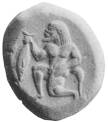 |
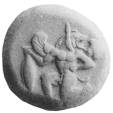 |
| FIG. 269. | FIG. 270. |
Nike (?) running. Herakles with club and bow. Triton (?). Satyr holding tunny (Fig. 269). Young male figure with knife. Young male figure with helmet and sword. Naked figure holding tunny. Winged male figure with tunny. Lion-headed male figure (Phobos ?, Fig. 270).
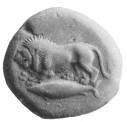
Sphinx with two bodies (hecte). Lion’s scalp. Head of lioness. Lion (Fig. 271). Lioness. Forepart of winged lioness. Rain. Forepart of winged boar. Winged boar. Pistrix. Cock (forepart). Chimaera. Winged bull. Griffin. Heads of lion and ram conjoined.
Zeus Ammon. Apollo. Athena. Dionysos. Herakles. Aktaeon. Young male head (Kyzikos ?, G. No. 80). Female head in sakkos (cf. Syra-
 |
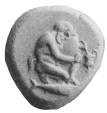 |
| FIG. 272. | FIG. 273. |
Zeus kneeling with eagle and sceptre. Poseidon kneeling. Poseidon on sea-horse. Triptolemos in serpent-car. Apollo shooting. Demeter holding torch. Gaia holding Erichthonios (Fig. 272). Kekrops with olive-branch. Infant Dionysos (G. No. 39). Satyr filling wine-cup (Fig. 273). Satyr drinking from amphora. Satyr(?) holding in each hand uncertain object (B. M. C., Mysia, No. 68). Nereid on dolphin. Nike with aplustre. Nike flying (hecte). Herakles kneeling; seated; strangling lion; holding club and horn (N. C., 1896, p. 91). Infant Herakles with serpents (N. C., 1897, p. 255, hecte). Herakles and Iphikles. Orestes at Delphic omphalos. Harmodios and Aristogeiton. Taras (?) on dolphin. Youth on horseback (cf. Tarentum). Child holding tunny. Runner in armed foot-race. Helmeted youth examining arrow. Warrior kneeling with trumpet? (cf. R. N., 1901, p. 6). Odysseus slaying ram. Warrior protected by shield (G. No. 92). Seated Scythian with bow (G. No. 95). Europa on bull (R. N., 1901, p. 7).
Skylla. Centaur. Pegasos. Kerberos. Griffin. Forepart of man- headed bull (cf. Gela). Man-headed bull (N. C., 1892, p. 96). Bull's head. Bull. Forepart of winged bull. Head of goat. Goat. Boar. Sow. Winged dog. Dog. Fox (B. M., hecte). Horse. Ass. Ram (G. Nos. 130-132). Eagle. Winged dolphin (hecte). Forepart of deer (N. C., 1897, p. 254). Helmet. Prow. Lyre. Delphic omphalos with two eagles (B. M. C., Mysia, No. 100).

Bearded Kabeiros. Aphrodite wearing stephane. Bearded male head, laureate (N. C., 1898, p. 197). Demeter or Kore, profile (two types, N. C., 1897, p. 253); also facing (Fig. 274). Young Dionysos. Pan (G. No. 40). Atys. Gorgoneion (N. C., 1893, p. 82).
Apollo on swan; also on griffin. Apollo with lyre. Helios holding two horses. Demeter with torch. Young Dionysos seated on rock. Aphrodite and Eros. ΕΛΕΥΘΕΡΙ(a) seated (R. N., 1908, p. 421). Kybele on lion. Perseus with Gorgon’s head. Man restraining horse (N. C., 1897, p. 254). Naked male figure kneeling, looking back (N. C., 1893, p. 81).
| Head and tail of fish (tunny ?). [B. M. C., Mysia, Pl. III. 21.] | Rude incuse square. AR 220 grs. |
| Forepart of boar; behind, tunny. [B. M. C., Mysia, p. 34.] |
Head of lion; incuse square.
AR 20 grs., and smaller pieces.
(Also with rev. Two tunnies).[Imh., Kleinas. M., p. 22.] |
For a tetradrachm bearing the name and portrait of the Satrap Pharnabazus, struck at Cyzicus, see ‘Satrapal Coins' (under Ionia) infra.
| ΣΩΤΕΙΡΑ Head of Kore Soteira
wearing corn-wreath and veil. [B. M. Guide, Pl. XVIII. 8.] |
ΚΥΖΙ Lion’s head; beneath, tunny.
AR 233 grs.
(Also some of later style with ΚΥΖΙ-
ΚΗΝΩΝ.)
|
| Similar; beneath, tunny. [Cf. parasaemonπαρασημον on stele of proxeniaπροξενια, J. H. S., 1904, p. 38.] | ΚΥΖΙ Apollo, seated on omphalos, be-
side which, lyre.
AR 205 grs. and 196 grs. [B. M.
Guide, Pl. XXIX. 27]; also
90 grs. [N. C., 1897, p. 112]. |
| Head of Kore Soteira. | ΚΥΖΙ Tripod; beneath, tunny.
Æ .7-.45 |
| Head of Apollo. | ΚΥΖΙ Tripod; beneath, tunny. [Imh., Kleinas. M., p. 22]. Æ .7 |
| Head of Apollo. | ΚΥΖΙ Amphora and tunny. [Kleinas. M., p. 22]. Æ .3
|
| Head of Kore Soteira. | Monogram in wreath; beneath, ΚΥ.
Æ .6 |
| Tunny in corn-wreath. | ΚΥΖΙ Monogram in wreath. Æ .65 |
| Bull’s head. | ΚΥΖΙ Term (Apollo ?). [Kleinas. M., p. 22]. Æ .5 |
| Female head in diadem and oak-wreath. [Kore Soteira : Imh., Kleinas. M., p. 23 f.]. |
ΚΥΖΙΚΗΝΩΝ torch in oak wreath.
AR 252 grs. |
| Head of Kore Soteira. [N. C., 1902, p. 329.] |
ΚΥΖΙ Tunny in oak-wreath.
AR 24 grs.
|
Bronze with types relating to Kore Soteira; Long torch; Head of Athena; Bull; Bucranium; Sphinx (Kleinas. M., p. 505); Apollo, &c. Inscr., ΚΥΖΙ; ΚΥΖΙΚΗΝΩΝ.
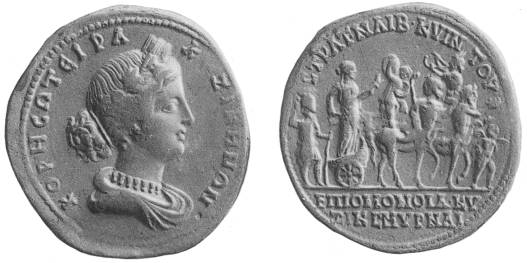
Imperial— Augustus to Claudius Gothicus. Also quasi-autonomous of all periods. Inscr., ΚΥΖΙΚΗΝΩΝ, usually with ΝЄΟΚΟΡΩΝ or ΔΚ ΝЄΟΚΟΡΩΝ; ΚΥΖΙ.
Types. Bust of ΚΟΡΗ CΩΤЄΙΡΑ (or Faustina II as Kore, Fig. 275); Zeus; Poseidon; Apollo with foot on omphalos (B. M. C., Mysia, p. 51, No. 239); Ares; Hermes; ΑΘΗΝΑ ΣΩΤΙΡΑ holding Nike (Imh., Gr. M., p. 614); Asklepios; Hephaestos seated; Dionysos seated on panther; Dionysos in car drawn by panthers (Gr. M., p. 615); Dionysos feeding panther; LiknophorosΛικνοφορος (Gr. M., p. 615); Dancing satyr and nymph (cf. Journ. Int., 1902, p. 179); Eros; Eirene and Ploutos; Male figure reclin- ing and M. Aurelius sacrificing (B. M. C., Mysia, p. 41, No. 175); Male figure in star-spangled dress reclining (B. M. C., Mysia, p. 50, No. 236); Antinoüs; Artemis; Demeter, attended by Maenad, in car drawn by Centaurs and Pan, with Eros in front and liknophorosλικνοφορος behind (Fig. 275). Galley. Stork. Calf. Lion and ox (Kleinas. M., p. 26). She-wolf (Imh., Gr. M., p. 613). Ostrich (Gr. M., p. 613). Circular building, on each side, torch entwined by serpent (Imh., Gr. u. röm. Münzkunde, 1908, p. 41); Temple; Torch entwined by serpent and ears of corn and poppies. Herdsman milking goat (Z. f. N., xv. 42). The founder ΚΥΖΙΚΟC,
bust and figure (B. M. C., Mysia, p. 47 n.). Tyche of Cyzicus. River- god ΑΙCΗΠΟC. Armed athletes running (B. M. C., Mysia, Pl. XIV. 5). Erection of palms at a festival (B. M. C., Mysia, p. 55, No. 264; Imh., Kleinas. M., p. 25, No. 13). Triton holding oar. Rape of Persephone.
Magistrates: Strategos; Archon; Fuscus, proconsul of Asia under Trajan. Games. ΟΛΥΜΠΙΑ. Alliance coins. Ephesus, Smyrna (Fig. 275).
Eleutherion, polichnion Musiasπολιχνιον Μυσιας (Steph. Byz.). The following fourth- century coin may belong to this place: obv. Head of Athena facing, rev. ΕΛΕΥ Lion standing. Æ size .45 (Imh., Kleinas. M., p. 19).
Gambrium. The earliest coins bear the name of its dynast Gorgion (circ. B.C. 399) mentioned by Xenophon, Hell. iii. 1. 6 :—
| Head of Apollo. [N. C., 1894, p. 315.] |
ΓΟΡΓΙ Forepart of rushing bull.
AR 52 grs.; also 24 grs. Cf. Æ with
ΓΟΡ, Z. f. N., 1902, p. 191.
|
| Head of Apollo. [B. M. C., Mysia, p. 62.] |
ΓΑΜ Forepart of rushing bull.
Æ 26 grs.
|
Also Æ with inscr. ΓΑΜ, obv. Head of Apollo and various reverses; Star, Head of Medusa, Bull charging, Tripod.
Hadriani ad Olympum, on the left bank of the Rhyndacus, at Beyidje, on a spur of Mount Olympus (Hill, Journ. Int., i. 241; Imh., Kleinas. M., p. 20).
Imperial— Hadrian to Gallienus. Also quasi-autonomous. Inscr., ΑΔΡΙΑΝΩΝ sometimes with ΠΡΟC ΟΛΥΜΠΩ. Types—Zeus; Athena; Asklepios; Telesphoros; Dionysos in biga of Centaurs; Artemis; De- meter; infant Hermes in cradle, &c. Magistrate, Archon.
Hadrianeia (Hill, Journ. Int., i. 241; Imh., Kleinas. M., p. 20). Im- perial— Hadrian to Otacilia Severa. Also quasi-auton. Inscr., ΑΔΡΙΑ- ΝΕΩΝ. Types— Bust of Senate; Head of ΑΗΜΟC; Zeus; Athena; Artemis; Telesphoros; Hermes standing before River-god reclining beneath tree; Kybele in lion-car. Magistrates, Archon, Strategos.
Hadrianothera, founded by Hadrian in commemoration of successful hunting excursions. Imperial— Hadrian to Philip. Also quasi-auton. Inscr., ΑΔΡΙΑΝΟΘΗΡΙΤΩΝ. Types— Asklepios; Zeus, &c. Also obv. Boar’s head, rev. Telesphoros (N. C., vi. 115). Magistrates, Archon, Strategos.
Iolla, probably near Adramyteum (Imhoof, Mon. Gr., p. 245). Bronze coins of the fourth century B.C. Inscr., ΙΟΛΛΑ or ΙΟΛΛΕΩΝ. Types — Head of Athena or of Zeus, rev. Forepart of winged horse. Some of the silver and bronze coins of the Satrap Orontas are by some numis- matists thought to have been struck at Iolla, and by others at Lamp- sacus. See ‘Satrapal Coins‘ (under Ionia) infra.
Lampsacus. The coinage of this celebrated city on the Hellespont consists of the following classes :—
| Forepart of winged horse; above, acan- thus ornament. | Quadripartite incuse square.
EL. 216 grs.
(The attribution of this stater and of
similar staters with animal types is
not certain; see B. M. C., Mysia,
p. 78 n.) |
| Forepart of winged horse. | Quadripartite incuse square. AR Didr.
105 grs.; Tetrob. 36 grs.; Triob.
21 grs. (Phoenician standard).
|
About the close of the sixth century the Phoenician standard is aban- doned for the Persic, and silver coins of the weight of the Persian siglos and its divisions are met with. The weight of the electrum stater appears about the same time to have been raised.
| Forepart of winged horse; sometimes
in vine-wreath. [Babelon, Traité, Pl. VIII. 1-4.] |
Quadripartite incuse square.
EL. Stater, 237 grs. |
| Janiform female head, of archaic style. [B. M. Guide, Pl. II. 18.] | Head of Athena, of archaic style in
incuse square.
AR Persic Drachm (83 grs.) and
subdivisions.
|
The electrum pieces appear to be the coins mentioned in Attic inscrip- tions (circ. B.C. 434), as chrusou stataeres Lampsakaenoiχρυσου στατηρες Λαμψακηνοι (Num. Chron., 1876, p. 290 : see also Babelon, Rev. Num., 1895, p. 35).
In this period the use of an electrum currency seems to have been finally abandoned at Lampsacus, and its place supplied by staters of pure gold struck on the standard of the gold darics (wt. 131 grs.: for references in inscriptions see Babelon, Traité, i. p. 491 n.). Among them are some of the most beautiful examples of Greek coin-art. The reverse type is uniformly the forepart of a winged horse in an incuse square. The following types of the obverse are known. These varying types are probably magistrates’ symbols, as on the electrum coins of Cyzicus; cf. Macdonald, Coin Types, pp. 41, 50. (See list with plates by Miss A. Baldwin in Journ. Int., 1902, p. 5 f.)
 |
 |
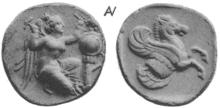 |
| FIG. 276. | FIG. 277. | FIG. 278. |
Infant Herakles strangling serpents. Helle seated on ram. Nereid on dolphin. Male figure (Orpheus ?) seated, with lyre. Nike killing ram (Fig. 276). Gê rising from ground (Fig. 277). Nike erecting trophy (Fig. 278).
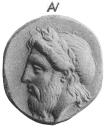 |
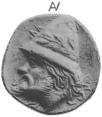 |
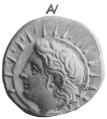 |
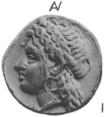 |
| FIG. 279. | FIG. 280. | FIG. 281. | FIG. 282. |
Zeus with or without fulmen (Fig. 279). Hera. Zeus Ammon. Athena (three types). Aphrodite. Demeter. Persephone. Hermes. Female head in lotus- wreath. Hekate. Kabeiros bearded (Fig. 280). Helios on radiate disk (Fig. 281). Winged head (Nike, or Eros?; cf. J. H. S., 1897, p. 85). Dionysos bearded. Bacchante, with flowing hair; also with hair in sakkos and with hair falling on neck. Herakles bearded. Male head in stephane; behind it, club ? (Baldwin, No. 29). Female satyr (Fig. 282). Pan, beardless, with goat’s horn. Satyr, three-quarter face. Aktaeon, with stag’s horn. Head in Persian head-dress. Young male head (Baldwin, No. 35). Female head, hair rolled, with ear-ring (ib., No. 36).
| Janiform female head. | ΛΑΜ or ΛΑΜΨΑ Head of Athena.
AR of Persic standard, 39 grs., &c. |
| Head of Athena. | ΛΑΜ Forepart of winged horse.
AR 36 grs. |
| Head of Apollo. | ΛΑΜ Id. AR 19 grs.
|
There are also bronze coins of the fourth and third centuries; inscr., ΛΑΜ or ΛΑΜΨΑ; rev. usually Forepart of winged horse, obv. types; Janiform female head, Head of Nike (?) in laurel-wreath, Head of Athena, &c. For the fourth-century coins of the Satraps, Orontas and Spithridates, probably struck at Lampsacus, see infra Satrapal Coins (under Ionia infra).
Tetradrachms and drachms of Alexander the Great’s types, but of later style, have been attributed by Müller (Nos. 912-17) to Lampsacus. The symbol is the winged horse.
After the battle of Magnesia, Lampsacus was one of the towns upon which the Romans conferred autonomy.
| Head of Priapos, ivy-crowned and
horned. [B. M. Guide, Pl. XLIX. 8.] |
ΛΑΜΨΑΚΗΝΩΝ Apollo Kitharoedos,
and magistrates’ names with patro-
nymic. AR Attic Tetradr.
|
There are also Æ, inscr. ΛΑΜ, ΛΑΜΨΑΚΗΝΩΝ, types relating to Priapos, Apollo, Athena, &c.
Lampsacus was one of the chief seats of the worship of Priapos, who had there the attributes of Dionysos (Virg. Georg. iv, 111; Athen. i. 54),
Imperial— Augustus to Gallienus. Inscr., ΛΑΜΨΑΚΗΝΩΝ; ΛΑΝΨΑ- ΚΗΝΩΝ. Types— Statue of Priapos, sometimes in temple; Forepart of winged horse; Poseidon; Kybele; Athena; Phrixos and Helle (Z. f. N., vii. p. 25); Herakles and Omphale (Hunter Cat., Pl. XLVIII. 5). Magis- trate, Strategos. Alliance coins with Phocaea.
Miletopolis (Melde near Kermasti), & town said to have been of Athenian origin, situated at the confluence of the rivers Macestus and Rhyndacus, in the northern part of Mysia. Bronze of fourth to first century B.C. Inscr. ΜΙΛΗΤΟ; ΜΙΛΗΤΟΠΟΛΙΤΩΝ. Types— obv. Head of Athena, rev. Owl, usually with double body; also Young male head, rev. Bull. Imperial— Trajan to Gordian III. Inscr., ΜЄΙΛΗΤΟΠΟ- ΛЄΙΤΩΝ. Types— Hermes; Athena, &c. Armed figure of ΜЄΙΔΗΤΟC ΚΤΙCΤΗC (specimens found near Melde, N. C., 1906, p. 33). Mag. Epi- meletes; Strategos.
Parium, on the Propontis between Lampsacus and Priapus. With regard to early electrum coins of the Gorgoneion type possibly struck at Parium see B. M. C., Mys., p. 94. Parium also coined, in all proba- bility, the following silver pieces during the archaic period, and later.
| Gorgoneion. [B. M. C. Mysia, Pl. XXI. 6.] | Incuse square containing a cruciform pattern. AR 69, 50, and 36 grs. |
| Gorgoneion, entwined with serpents. | ΠΑ ΡΙ Bull looking back; symbols, various. AR 38 grs (Persic Hemidrachm). |
Bronze coins: obv. Bull, rev. The great altar of Parium built by Hermocreon (Strabo x. 5, 7; xiii. 1, 13; cf. Jahrbuch arch. Inst., xi. 1896 (1897), p. 56). Also rev. Torch.
The next class of Parian silver coins cannot be earlier than the beginning of the second century B.C.
| Gorgoneion [Hunter Cat., II, Pl. XLVIII. 10.] | ΠΑΡΙΑΝΩΝ Nike with wreath. AR Rhodian Tetradr. 210 grs. |
| Head of Demeter [B. M. C., p. 99.] | ΠΑΡΙΑΝΩΝ ΑΠΟΛΛΩΝΟΣ ΑΚΤΑΙΟΥ and name of magistrate. Apollo Aktaeos (cf. Strabo xiii., 1, 13), holding lyre, standing between altar and omphalos. AR Attic Tetradr. |
Also Æ. ΠΑ ΡΙ, ΠΑΡΙΑΝΩΝ; types, Heads of Zeus, Athena, Hermes, Medusa; Fulmen; Bull; Eagle; Stag; Altar; Sistrum, &c.
Colonial Coinage
Augustus to Gallienus. Inscr. usually C.G.I.H.P. = Colonia Gemella Julia Hadriana Pariana. Types—PARIO CONDIT Head of the founder Parios; DEO CVPIDINI Eros standing (after Praxiteles), (N. C., 1893,Pergamum (Bergama). According to one tradition Pergamum was colonized from Epidaurus under the leadership of the god Asklepios. The coins struck before the establishment of the Pergamene kingdom are mainly as follows:—
| Head of Apollo. | ΠΕΡΓΑ or ΠΕΡΓ Bearded male head
(Satrap) in Persian head-dress.
AR 24 grs.; also AR 11 grs. |
| Head of Apollo. | ΠΕΡΓ Bull’s head. AR 9 grs. |
| Head of Apollo (cf. Imh., Gr. M., p. 93). | ΠΕΡΓΑ Two bulls’ heads facing one
another. Æ .35 |
| Head of Apollo. | ΠΕΡΓ Boar’s head. Æ .4 |
| Female head (cf. Imh., Gr. M., Pl. VII. 8). | ΠΕΡΓ, &c. Two boars’ heads; also
two bulls’ heads. Small Æ
|
The earliest coins belong to the time of the dynasty of Gongylos, who ruled under Persian favour; on the chronology see von Fritze in Corolla Num., p. 47 f.
| Head of young Herakles. | Palladium [N. C., 1890, p. 198]. AV 133 grs. |
| Head of Athena. | Palladium [B. M. Guide, Pl. XLIX. 9]. AV 45 grs. |
| Head of young Herakles. | ΠΕΡΓΑ, ΠΕΡΓΑΜΗ, &c. Palladium.
Æ 20 grs. |
| Head of Athena. | ΠΕΡΓΑ Two bulls’ heads facing one
another. Æ .7 |
| Head of Athena. | ΠΕΡΓΑ Bull’s head. Æ .65 |
| Head of young Herakles. | ΠΕΡ Head of Athena. Æ .4 |
| Head of Athena. | ΠΕΡΓ Two stars. Æ .4 |
The AV and the earliest AR were supposed by J. P. Six (N. C., 1890, p. 200) to have been issued in B.C. 310 by Herakles of Pergamum, son of Alexander the Great and Barsine, but they may be better assigned to the period of Lysimachus (von Fritze, l. c.). For later coinage of Pergamum see infra, p. 535.
Philetaerus, B.C. 284-263, was the treasurer selected by Lysimachus to guard his hoard of 9,000 talents deposited at Pergamum. In B.C. 284 he made himself independent, though his tetradrachms show that he recognized Seleucus Nicator as his suzerain.
| Head of young Herakles. [B.C. 284-281.] |
ΣΕΛΕΥΚΟΥ ΒΑΣΙΛΕΩΣ Zeus seated
holding eagle; symbols, bust of
Athena and crescent. Tetradr. |
| Head of Seleucus Nicator, divinized. | ΦΙΛΕΤΑΙΡΟΥ Athena seated; out-
stretched hand on shield; above,
ivy-leaf; on r., bow. Tetradr.
|
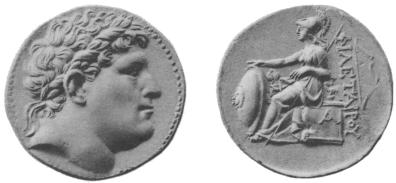
Eumenes I, B.C. 263-241, nephew of Philetaerus.
| Head of Philetaerus wearing diadem; also with diadem and laurel-wreath entwined. | ΦΙΛΕΤΑΙΡΟΥ Athena seated; out-
stretched hand on shield; beneath
arm, ivy-leaf; on r., bow (Fig. 283).
Tetradr.
|
Attalus I, B.C. 241-197, another nephew of Philetaerus.
| Head of Philetaerus wearing wreath with tie. (Also head with laurel- wreath and diadem entwined, At- talus I or Eumenes II ?.) | ΦΙΛΕΤΑΙΡΟΥ Athena seated, crown-
ing king’s name; shield behind her;
on r., bow : symbols, ivy-leaf, grapes.
Tetradr.
(Cf. Wace in Journ. Int., 1903,
p. 143, and in J. H. S., 1905, 98.)
|
Eumenes II, B.C. 197-159, eldest son of Attalus I.
| Head of Philetaerus wearing diadem and laurel-wreath entwined. | ΦΙΛΕΤΑΙΡΟΥ Type as on coins of At-
talus I, with symbols, bee, star, palm,
cornucopiae, &c., and monograms.
Tetradr. |
| Head of Eumenes II, wearing diadem. [B. M. C., Mys., p. 117; cf. Z. f. N., xxiv. p. 118.] |
ΒΑΣΙΛΕΩΣ ΕΥΜΕΝΟΥ Two youths
(Kabeiri or Dioskuri) standing
facing, each holding a spear: whole
in laurel-wreath. Tetradr.
|
For Alexandrine coins, probably of the time of Eumenes II, see Imhoof, op. cit., pp. 16, 17.
Attalus II (Philadelphus), B.C. 159-138, younger brother of Eu- menes II.
| Head of Philetaerus with diadem and laurel-wreath entwined. | ΦΙΛΕΤΑΙΡΟΥ Athena seated, &c., as
on the tetradr. of Eumenes II; with
various symbols and monograms :
flat, spread fabric. Tetradr.
|
Attalus III (Philometor), B.C. 138-133, bequeathed the kingdom of Pergamum to the Roman people. He does not appear to have issued coins.
Inscr. throughout, ΦΙΛΕΤΑΙΡΟΥ. Many of the reverse types and symbols are identical with the symbols of the tetradrachms, and this identity furnishes the chief clue to their attribution to the various kings (see Imhoof, op. cit.; B. M. C., Mys., p. 119 f.). Obverses, Head of Athena; Head of Apollo; Head of Asklepios. Reverses, Bow; Ivy-leaf; Star; Bee; Tripod; Thyrsos; Bow; Serpent coiled; Asklepios seated feeding serpent from phiale (probably after the statue of Phyroma- chus, Wroth, Num. Chron., 1882, p. 14; von Fritze, Nomisma, ii. p. 19 f.); Temple-key and serpent. Also with obv. Head of Philetaerus, rev. ΦΙΛΕΤΑΙΡΟΥ Female figure seated l. holding wreath (Brit. Mus. (authenticity doubtful)).
Under the kings of the Pergamene dynasty the so-called Cistophori made their first appearance as the chief medium of circulation for Western Asia Minor. The Cistophorus was so named from its type, the Sacred Bacchic Chest or Cista. According to Dr. Imhoof (Die Münzen der Dynastie von Pergamon, p. 33) this coinage originated at Ephesus shortly before B.C. 200, and its use rapidly extended throughout the dominions of Attalus I of Pergamum. Henceforth the Cistophorus became a sort of Pan-Asiatic coin, its general acceptance being secured by the uniformity of its types, while the local mint-letters and magistrates’ symbols were merely subordinate adjuncts. The institution of this quasi-federal coinage in Asia Minor may have been suggested by the popularity of the Federal money of the Achaean League in Peloponnesus, as well as by the eager adoption by so many Asiatic cities of Alexandrine tetradrachms. The manifold advantages of a uniform currency were evidently beginning to be understood and widely appreciated in the ancient world about this time, and the cistophorus, whether intention- ally coined for this purpose or not, met the popular demand, and was issued in vast quantities from numerous Asiatic mints (cf. Livy xxxvii. 46, 58, 59, and xxxix. 7).
The types of the Cistophori may be thus described.
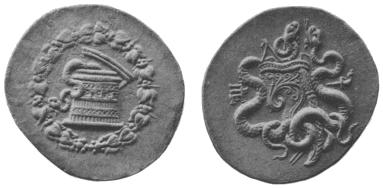
| Cista mystica, with half-open lid, from which a serpent issues; the whole in wreath of ivy. (Fig. 284.) | Two coiled serpents, with heads erect;
between them, a bow-case.
AR Tetradr. 195 grs.
|
| Club and lion-skin of Herakles; the
whole in wreath of ivy, vine, or laurel. (Num. Chron., 1880, Pl. VIII. 12.) |
Bunch of grapes placed on a vine-leaf.
AR Didr. 92 grs.
AR Drachm. 46 grs. |
Cistophori are known to have been issued at the following mints in Asia Minor:— Adramyteum and Pergamum in Mysia; Ephesus and Smyrna in Ionia; Apollonis, Thyateira, Nysa, Sardes, Stratoniceia ad Caïcum, and Tralles in Lydia; Apameia, Laodiceia, and Synnada in Phrygia; also in Crete (see supra, p. 479). See Pinder, Über die Cisto- phoren, 1856.
The cistophori of Pergamum may be divided into four classes. With very few exceptions all the specimens bear the letters ΠΕΡ in monogram.
In the field of the reverse, to the right of the serpents, a changing symbol—torch, caduceus, thyrsos, &c.
In field, as a constant symbol the snake-entwined Asklepian staff, often with the addition of the letters ΠΡΥ in monogram, standing for PrutanisΠρυτανις, together with abbreviated magistrates’ names.
Series of Proconsular cistophori, bearing the names of the Proconsuls C. Fabius, B.C, 57-56, with local magistrates’ names ΜΗΝΟΦΙΛΟΣ and ΔΗΜЄΑC; C. Claudius Pulcher, B.C. 55-54 (?), with local magistrates’ names, ΜΗΝΟΔWΡΟC, &c. (B. M. C., Mys., p. xxx; N. C., 1899, p. 97).
Cistophorus struck by Q. Caecilius Metellus Pius Scipio as ‘Impe- rator’; Legionary Eagle, in place of Bow-case, between serpents on reverse (B. M. Guide, Pl. LX. 5). (For a cistophorus probably struck B.C. 50-49 by L. Antonius as Q[uaestor] see N. C., 1893, p. 10.)
The bronze coins (sizes 1.-.6) described below have been generally ascribed to the period (B.C. 133 to Augustus) when the Pergamene kingdom and its capital became part of the Roman province of Asia. Von Fritze (Corolla Num., p. 47 f.) has, however, shown reasons for assigning them to the later period of the Pergamene kingdom, circ. B.C. 200-133. They would thus be a civic issue supplementing the regal issue of bronze coins. It may be doubted whether any bronze coins were struck at Pergamum between B.C. 133 and the time of Augustus.
| Bust of Athena. | ΠΕΡΓΑΜΗΝΩΝ Asklepios standing. |
| Head of Athena. | „ Nike standing. |
| Head of Asklepios. | „ Eagle on fulmen. |
| „ „ | ΑΣΚΛΗΠΙΟΥ ΣΩΤΗΡΟΣ Serpent- staff. |
| „ „ | ΑΣΚΛΗΠΙΟΥ ΣΩΤΗΡΟΣ Serpent coiled round netted omphalos. |
| Head of Apollo. | ΑΣΚΛΗΠΙΟΥ ΣΩΤΗΡΟΣ Tripod. |
| Head of Hygieia. | ΑΣΚΛΗΠΙΟΥ ΚΑΙ ΥΓΙΕΙΑΣ Serpent coiled round omphalos. |
| Head of Athena. | ΑΘΗΝΑΣ ΑΡΕΙΑΣ Owl (Mion.). |
| „ „ | ΑΘΗΝΑΣ ΝΙΚΗΦΟΡΟΥ Owl in wreath, or on fulmen, or on palm. (Cp. B. M. C., Mysia, p. 132 AR.) |
| „ „ | ΑΘΗΝΑΣ ΝΙΚΗΦΟΡΟΥ Trophy. |
| Head of Asklepios. | No inscr. Serpent coiled round crooked staff. |
The coin with ΑΘΗΝΑΣ ΝΙΚΗΦΟΡΟΥ, Owl in wreath, may have been struck B.C. 183 in connexion with the Nikephoria (von Fritze, op. cit., p. 56).
Imperial— Augustus to Gallienus. Also quasi-autonomous of same period. Inscr. ΠΕΡΓΑΜΗΝΩΝ. Types: Asklepios, Hygieia, Tele- sphoros. The Asklepian cultus was of great importance (see Wroth, ‘Asklepios and the coins of Pergamum,’ in N. C., 1882, pp. 1-51, and von Fritze, Nomisma, ii. pp. 18-35), and Asklepian types are abundant, especially under the Antonines and under Caracalla, who visited the Pergamene temple of Asklepios in A.D. 214. ΚΟΡΩΝΙC, mother of Asklepios, standing; Statue of Asklepios between rivers Keteios and Seleinos; Asklepios, small naked figure and rat (B. M. C., Mysia, p. 148); Caracalla adoring Asklepian serpent and Tele- sphoros (B. M. C., Mysia, p. xxxi); also sacrificing to Asklepios (ib.); ΘΕΟΝ CΥΝΚΛΗΤΟΝ, Head of Senate, rev. ΘΕΑΝ ΡΩΜΗΝ, Head of Roma; ΠЄΡΤΑΜΟC ΚΤΙCΤΗC, Head of hero Pergamos; Athena; Ar- menian (?) captive (Imh., Kleinas. M., p. 506); ΣΕΒΑΣΤΟΝ ΠΕΡΓΑ- ΜΗΝΟΙ, Augustus in temple; ΛΙΒΙΑΝ ΗΡΑΝ, Bust of Livia as Hera, rev. ΙΟΥΛΙΑΝ ΑΦΡΟΔΙΤΗΝ, Bust of Julia as Aphrodite; obv. Bust of ЄΥΡΥΠΥΛΟC ΗΡΩC, rev. Cypriote temple of Aphrodite (ΠΑΦΙΑ) (see B. M. C., Cyprus, Pl. XXVI. 7); ΖЄΥC ΦΙΛΙΟC; Temple of Rome and Augustus (B. M. C., Mysia, p. 142); River-god, ΚΑΙΚΟC; River-god, ΚΗΤΕΙΟC; Apollo Smintheus (B. M. C., Mysia, p. 145); Satyr dancing the boy Dionysos on his foot (B. M. C., Mysia, p. 150); Youthful Zeus, Gaia and Thalassa (B. M. C., Mysia, p. 151); Ariadne sleeping (Z. f. N., xxiv, p. 74); Great Altar of Pergamum, with humped bulls in front (R. N., 1902, p. 234); Herakles and Erymanthian boar (Inv. Wadd.); Kabeiri (Z. f. N., xxiv. p. 120 f.).
Magistrates—Vettius Bolanus, M. Plautius Silvanus, Q. Poppaeus Secundus, P. Petronius, C. Antius, A. Julius Quadratus, Proconsuls of Asia. The usual local magistrate is a Strategos; also Grammateus, Hiereus, Gymnasiarch, Prytanis (a woman, B. M. C., Mysia, p. 145; cf. Ath. Mitth., 1899, p. 167), Theologos (N. C., 1894, p. 12).
Titles—ΝЄΩΚΟΡΩΝ, Β and Γ; ΠΡΩΤΩΝ; Η ΠΡΩΤΗ ΤΗC ΑCΙΑC
Games—ΠΡΩΤΑ ΟΛΥΜΠΙΑ ЄΝ ΠЄΡΓΑΜΩ (Gallienus).
Alliance coins—Nicomedia, Ephesus, Smyrna, Miletus, Sardes, Hiera- polis (Phryg.), Laodiceia (Phryg.).
Perperene, south-east of Adramyteum. Small autonomous bronze of the second or first century B.C. Head of Apollo, rev. ΠΕΡ, ΠΕΡΠΕ, Grapes. Imperial— Domitian to Otacilia. Also quasi-auton. Inscr., ΠΕΡΠΕΡΗ- ΝΙΩΝ. Types: Grapes; Telesphoros holding grapes; Asklepios; Two serpents at altar; Dionysos; Zeus; Athena; Demeter; Apollo (Imh., Kleinas. M., p. 506); Head of the Senate as town-goddess (ib. p. 32); Bust of the Imperial ΗΓЄΜΟΝΙΑ laureate, on coins of Caligula (ib. p. 32) and Nero.
Pitane, on the Elaean gulf near the mouth of the Euenus. Æ, end of fifth century B.C., wt. 5.6 grs., obv. Head r., rev. ΠΙΤΑΝΑ Pentagram (Brit. Mus.). Also Æ of fourth century B.C. to first century. Inscr., ΠΙ, ΠΙΤΑ, ΠΙΤΑΝΑΙΩΝ. Usual types: obv. Head of Zeus Ammon in profile or facing, rev. Pentagram. Also Head of Bacchante; Omphalos entwined by serpent. Imperial— Augustus to Otacilia. Inscr. ΠΙΤΑ- ΝΑΙΩΝ. Types: Round shield ornamented with pentagram; Head of Ammon; Telesphoros; Athena; Zeus; Prow; Amazon. Magistrates, P. Cornelius Scipio, Proconsul (with head): Strategos.
Placia, on the Propontis, between Cyzicus and the mouth of the Rhyndacus. Autonomous small bronze of the fourth century B.C. Inscr., ΠΛΑΚΙΑ or ΠΛΑ. Types— Head of Kybele, sometimes turreted, rev. Lion r.; Lion’s head; or Bull walking. On the worship of Kybele at Placia and Cyzicus, under the name of ae Maetaer Plakianaeη Μητηρ Πλακιανη, see Mitthei- lungen d. deutsch. arch. Inst., vii. 151.
Poemanenon, a dependency of Cyzicus, Æ of first century B.C. Type: Head of Zeus, rev. ΠΟΙΜΑΝΗΝΩΝ Fulmen. Imperial and quasi-auto- nomous— Trajan to Philip. Types: Head of ΗΟΙΜΗC the founder, rev. Hermes (Z. f. N., iii. 123); Eros (Invent. Wadd.); Tyche; Tripod en- twined by serpent; Zeus; Asklepios. Magistrate, Archon. (On the site of Poimanenon, cf. J. H. S., xxvi; p. 23.)
Priapus, a colony of Cyzicus near Parium. Autonomous bronze of the third and first centuries B.C. Inscr., ΠΡΙ ΑΠΗΝΩΝ or abbreviated.
| Head of Apollo. | Cray-fish (or lobster); also shrimp.
Æ .75-35 |
| Head of Artemis. | Stag recumbent. Æ .8 |
| Bearded head filleted r. | Amphora.
(Imhoof, Mon. gr., p. 258) Æ .45 |
| Head of Dionysos. | Amphora. Æ .7 |
| Head of Demeter veiled. | Stag and cista mystica. Æ .85
|
Proconnesus. An island in the Propontis, between Priapus and Cyzicus. Cf. Imh., Mon. gr., p. 259.
| Head of Aphrodite in sphendone or in saccos. | ΠΡΟΚΟΝ Oenochoë.
AR 39 grs, (Cf. N. C., 1904,
p. 301.) Also Æ. |
| Head of Aphrodite, hair in saccos. Magistrate, ΑΝΑΞΙΓΕΝΗΣ. | „ Stag recumbent; in front
oenochoë. AR 55 grs. (B. M.
Guide, Pl. XXIX. 28.) |
| Similar. | „ Forepart of stag and oeno-
choë. AR 55 grs. |
| Similar; no magistrate’s name. | „ „ AR 37 grs. |
| Head of Aphrodite. Magistrate’s name, ΔΙΑΓΟΡΑΣ. | „ Oenochoë. Æ .7-.35 |
| Head of Aphrodite. | „ Dove and oenochoë. Æ .55
|
The deer, proxπροξ, on the reverse of the drachm is a type parlant (Eckhel, ii. p. 477).
Teuthrania (Kalerga), between Pergamum and Pitane. Coins issued by the dynast Procles I, circ. B.C. 399 (Babelon, Mélanges, ii. p. 189 f.); cf. N. C., 1894, p. 318.
| Head of Apollo. | ΤΕΥ Young head in Persian tiara.
AR 25 grs.; also Æ. |
Thebe, called Hypoplacia, from its situation at the foot of Mount Placius. Small Æ of fourth century B.C., obv. Female head in saccos, rev. ΘΗΒ Three crescents united. (Imh., Kleinas. M., ii. p. 506.)